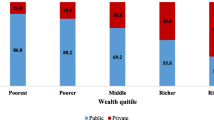Abstract
Large scale investment in the National Rural Health Mission is expected to increase the utilization and reduce the cost of maternal care in public health centres in India. The objective of this paper is to examine recent trends in the utilization and cost of hospital based delivery care in the Empowered Action Group (EAG) states of India. The unit data from the District Level Household Survey 3, 2007–2008 is used in the analyses. The coverage and the cost of hospital based delivery at constant price is analyzed for five consecutive years preceding the survey. Descriptive and multivariate analyses are used to understand the socio-economic differentials in cost and utilization of delivery care. During 2004–2008, the utilization of delivery care from public health centres has increased in all the eight EAG states. Adjusting for inflation, the household cost of delivery care has declined for the poor, less educated and in public health centres in the EAG states. The cost of delivery care in private health centres has not shown any significant changes across the states. Results of the multivariate analyses suggest that time, state, place of residence, economic status; educational attainment and delivery characteristics of mother are significant predictors of hospital based delivery care in India. The study demonstrates the utility of public spending on health care and provides a thrust to the ongoing debate on universal health coverage in India.




Similar content being viewed by others
Notes
The 18 high focused states covered under the NRHM include three broad categories, eight Empowered Action Group (EAG) states (Uttar Pradesh, Bihar, Madhya Pradesh, Rajasthan, Jharkhand, Chhattisgarh, Uttarakhand and Odisha), seven north-eastern states (Arunachal Pradesh, Manipur, Meghalaya, Mizoram, Nagaland, Tripura, Sikkim) and others (Assam, Jammu and Kashmir and Himachal Pradesh).
References
Ministry of Health and Family Welfare (MOHFW), & Government of India. (2005). National Rural Health Mission (2005–2012), Mission document. Accessed through http://mohfw.nic.in/NRHM/Documents/Mission_Document.pdf.
Ministry of Health and Family Welfare (MOHFW), & Government of India. (2009). National Health Accounts India 2004–2005.
High Level Expert Group. (2011). High Level Expert Group Report on Universal Health Coverage for India, (New Delhi).
Ministry of Health and Family Welfare (MOHFW), & Government of India. (2006). Maternal Health Division, New Delhi. Janani Suraksha Yojana: Features & frequently asked questions and answers. New Delhi: Ministry of Health and Family Welfare, Government of India. Accessed March 8, 2012.
Jones, N., Samuels, F., Gisby, L., & Presier-Marshall, E. (2011). Rethinking cash transfers to promote maternal health: Good practice from developing countries. Background Note, Overseas Development Institute.
Rowlings, L. B., & Rubio, G. M. (2005). Evaluating the Impact of conditional cash transfer programs. International Bank for Reconstruction and Development. Oxford: The World Bank, OUP.
Filmer, D., & Prichett, L. (1999). The impact of public spending on health: does money matter? Social Science and Medicine, 49(10), 1309–1323.
Rajkumar, S. A., & Swaroop, V. (2008). Public spending and outcome: Does governance matter? Journal of Development Economics, 86(2008), 96–111.
Bonu, S., Bhushan, I., Rani, M., & Anderson, I. (2009). Incidence and correlates of ‘catastrophic’ maternal health care expenditure in India. Health Policy and Planning, 24, 445–456.
Skordis-Worrall, J., Pace, N., Bapat, U., Das, S., More, N. S., Joshi, W., Pulkki-Brannstron, A. M., Osrin, D. (2011). Maternal and neonatal health expenditure in Mumbai slums (India): A cross sectional study. BMC Public Health. Accessed through www.biomedcentral.com/content/pdf/1471-2458-11-150.pdf.
Sharma, S., Smith, S., Pine, M., & Winfrey, W. (2005). Formal and informal Reproductive Healthcare User Fees in Uttaranchal, India. Washington: United States Agency for International Development.
Mohanty, S. K., & Srivastava, A. (2012). Out-of-pocket (OOP) expenditure on institutional delivery in India. Health Policy and Planning. doi:10.1093/heapol/czs05.
International Institute for Population Sciences (IIPS). (2010). District level household and facility survey (DLHS-3), 2007–08. Mumbai, India: International Institute for Population Sciences.
Union Budget and Economic Survey. (2012–2013). Annual Financial Statement. Accessed through http://indiabudget.nic.in/afs.asp, on June 12, 2012.
Mohanty, S. K. (2009). Alternate wealth index and health estimates in India. Genus, 65(2), 113–137.
Ministry of Finance, Government of India. (2009). Economic Survey 2008–09. New Delhi: Oxford University Press.
Navaneetham, K., & Dharamalingam, A. (2002). Utilisation of maternal health care, services in Southern India. Social Science and Medicine, 55(10), 1849–1869.
Pathak, P. K., Singh, A., & Subramanian, S. V. (2010). Economic inequalities in maternal health care: Prenatal care and skilled birth attendance in India, 1992–2006. PLoS ONE, 5(10), e13593.
Mohanty, S. K. (2012). Multiple deprivation on maternal care in India. International Perspectives on Sexual and Reproductive Health, 38(1), 6–14.
Lim, S. S., Dandona, L., Hoisington, J. A., James, S. L., Hogan, M. C., & Gakidou, E. (2010). India’s Janani Suraksha Yojana, a conditional cash transfer programme to increase births in health facilities: an impact evaluation. Lancet, 375(9730), 2009–2023.
Khan, M. E., Hazra, A., & Bhatnagar, I. (2010). Impact of Janani Suraksha Yojana on selected family health behaviour in rural Uttar Pradesh. The Journal of Family Welfare, 56(Special Issue), 9–22.
Office of the Registrar General of India (ORGI). (2011). Special bulletin on maternal mortality in India 2007–09. New Delhi, India: Office of the Registrar General.
Sharma, A. K. (2009). National Rural Health Mission: Time to Take Stock. Indian Journal of Community Medicine, 34(3), 175–182.
Ministry of Health and Family Welfare (MOHFW), & Government of India. (2011). Report of the working group on Drugs & Food Regulations. Accessed through http://planningcommission.nic.in/aboutus/committee/wrkgrp12/health/WG_4drugs.pdf.
Author information
Authors and Affiliations
Corresponding author
Appendix
Appendix
See Table 6.
Rights and permissions
About this article
Cite this article
Mohanty, S.K., Srivastava, A. Cost and Utilisation of Hospital Based Delivery Care in Empowered Action Group (EAG) States of India. Matern Child Health J 17, 1441–1451 (2013). https://doi.org/10.1007/s10995-012-1151-3
Published:
Issue Date:
DOI: https://doi.org/10.1007/s10995-012-1151-3




